Leadership and Management Report: Hilfiger Store UK Analysis
VerifiedAdded on 2021/02/20
|12
|3536
|45
Report
AI Summary
This report examines leadership and management principles within the context of Tommy Hilfiger's UK operations. It differentiates between leadership and management, outlining their respective roles and emphasizing the importance of trust and influence in leadership versus control in management. The report analyzes the application of these roles in various organizational situations, such as expansion and conflict resolution, and explores different leadership theories including situational, system, and contingency leadership. Furthermore, it delves into key approaches to operations management, such as Total Quality Management, and their significance in achieving business objectives. Finally, the report highlights the impact of environmental factors on decision-making by leaders and managers within the company, providing a comprehensive overview of leadership and management practices. This report is a student contribution to Desklib, a platform offering AI-powered study tools for students.
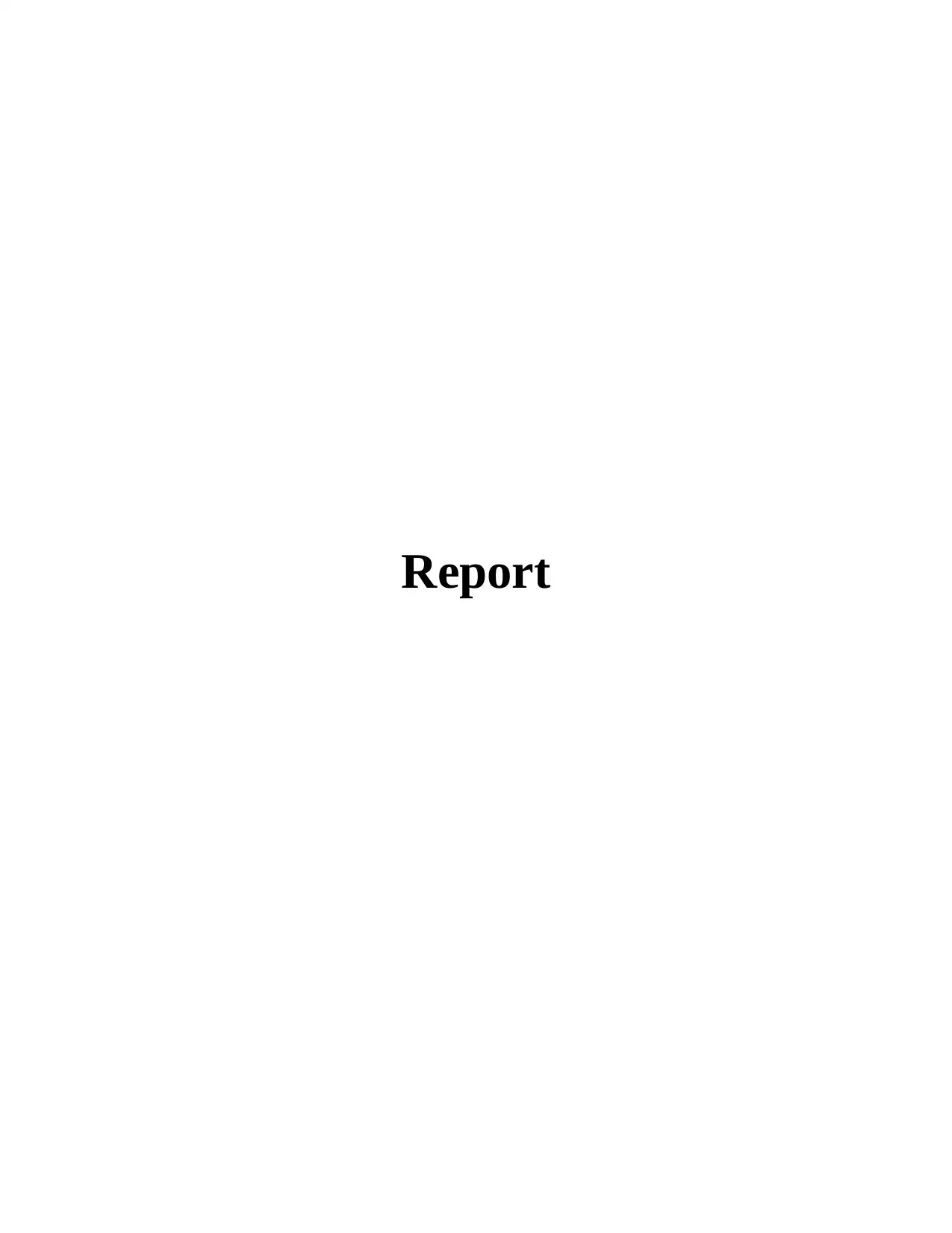
Report
Paraphrase This Document
Need a fresh take? Get an instant paraphrase of this document with our AI Paraphraser
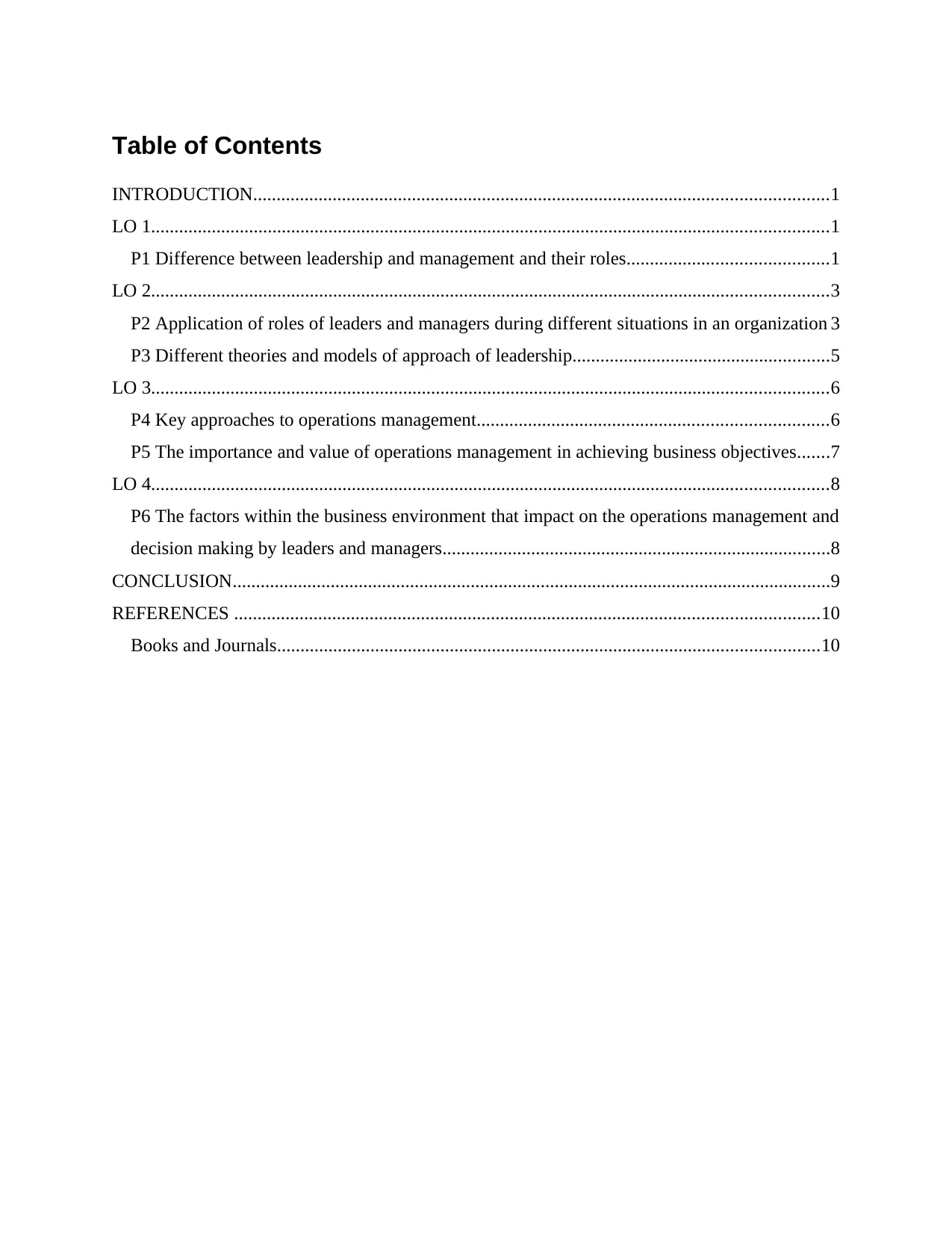
Table of Contents
INTRODUCTION...........................................................................................................................1
LO 1.................................................................................................................................................1
P1 Difference between leadership and management and their roles...........................................1
LO 2.................................................................................................................................................3
P2 Application of roles of leaders and managers during different situations in an organization 3
P3 Different theories and models of approach of leadership.......................................................5
LO 3.................................................................................................................................................6
P4 Key approaches to operations management...........................................................................6
P5 The importance and value of operations management in achieving business objectives.......7
LO 4.................................................................................................................................................8
P6 The factors within the business environment that impact on the operations management and
decision making by leaders and managers...................................................................................8
CONCLUSION................................................................................................................................9
REFERENCES .............................................................................................................................10
Books and Journals....................................................................................................................10
INTRODUCTION...........................................................................................................................1
LO 1.................................................................................................................................................1
P1 Difference between leadership and management and their roles...........................................1
LO 2.................................................................................................................................................3
P2 Application of roles of leaders and managers during different situations in an organization 3
P3 Different theories and models of approach of leadership.......................................................5
LO 3.................................................................................................................................................6
P4 Key approaches to operations management...........................................................................6
P5 The importance and value of operations management in achieving business objectives.......7
LO 4.................................................................................................................................................8
P6 The factors within the business environment that impact on the operations management and
decision making by leaders and managers...................................................................................8
CONCLUSION................................................................................................................................9
REFERENCES .............................................................................................................................10
Books and Journals....................................................................................................................10
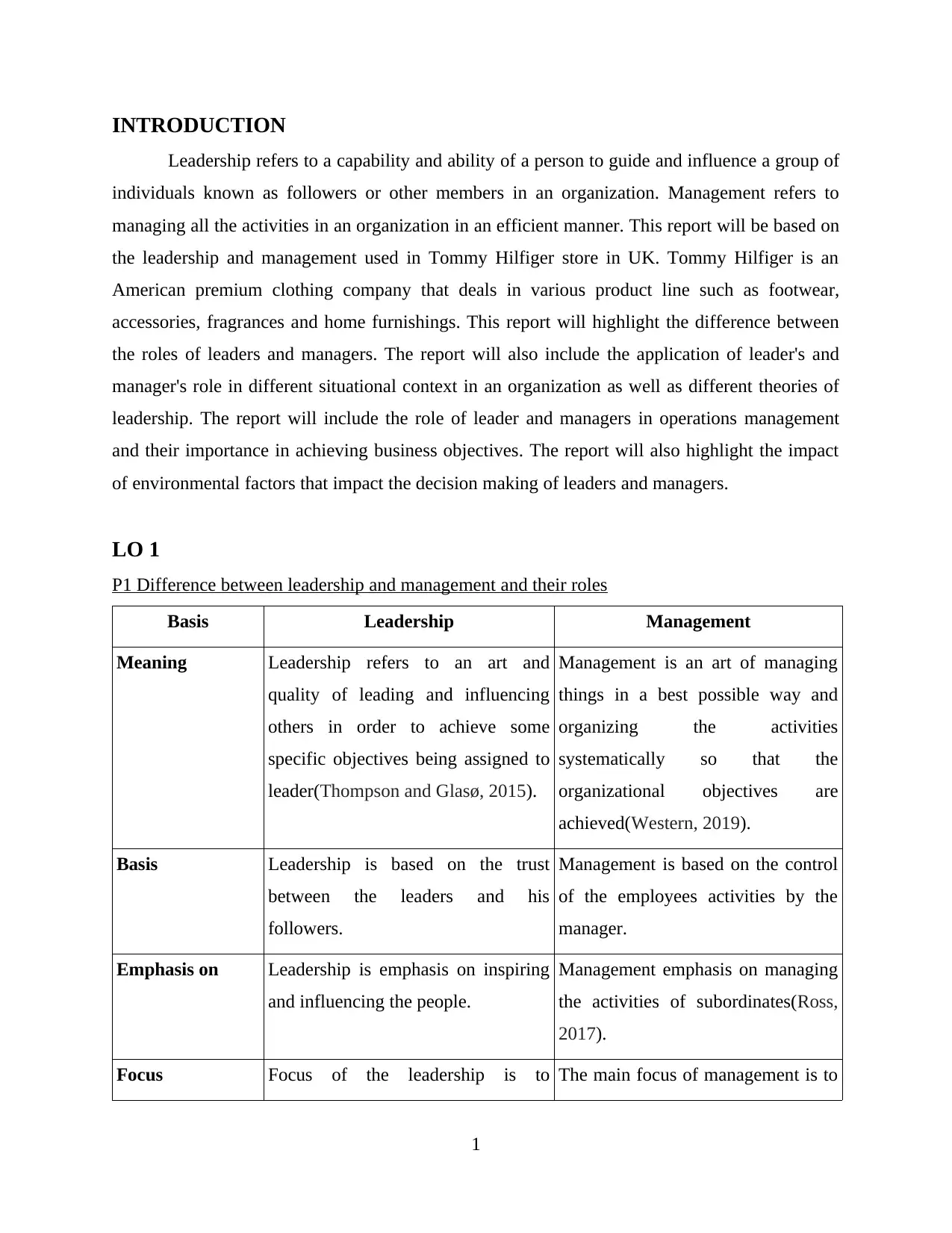
INTRODUCTION
Leadership refers to a capability and ability of a person to guide and influence a group of
individuals known as followers or other members in an organization. Management refers to
managing all the activities in an organization in an efficient manner. This report will be based on
the leadership and management used in Tommy Hilfiger store in UK. Tommy Hilfiger is an
American premium clothing company that deals in various product line such as footwear,
accessories, fragrances and home furnishings. This report will highlight the difference between
the roles of leaders and managers. The report will also include the application of leader's and
manager's role in different situational context in an organization as well as different theories of
leadership. The report will include the role of leader and managers in operations management
and their importance in achieving business objectives. The report will also highlight the impact
of environmental factors that impact the decision making of leaders and managers.
LO 1
P1 Difference between leadership and management and their roles
Basis Leadership Management
Meaning Leadership refers to an art and
quality of leading and influencing
others in order to achieve some
specific objectives being assigned to
leader(Thompson and Glasø, 2015).
Management is an art of managing
things in a best possible way and
organizing the activities
systematically so that the
organizational objectives are
achieved(Western, 2019).
Basis Leadership is based on the trust
between the leaders and his
followers.
Management is based on the control
of the employees activities by the
manager.
Emphasis on Leadership is emphasis on inspiring
and influencing the people.
Management emphasis on managing
the activities of subordinates(Ross,
2017).
Focus Focus of the leadership is to The main focus of management is to
1
Leadership refers to a capability and ability of a person to guide and influence a group of
individuals known as followers or other members in an organization. Management refers to
managing all the activities in an organization in an efficient manner. This report will be based on
the leadership and management used in Tommy Hilfiger store in UK. Tommy Hilfiger is an
American premium clothing company that deals in various product line such as footwear,
accessories, fragrances and home furnishings. This report will highlight the difference between
the roles of leaders and managers. The report will also include the application of leader's and
manager's role in different situational context in an organization as well as different theories of
leadership. The report will include the role of leader and managers in operations management
and their importance in achieving business objectives. The report will also highlight the impact
of environmental factors that impact the decision making of leaders and managers.
LO 1
P1 Difference between leadership and management and their roles
Basis Leadership Management
Meaning Leadership refers to an art and
quality of leading and influencing
others in order to achieve some
specific objectives being assigned to
leader(Thompson and Glasø, 2015).
Management is an art of managing
things in a best possible way and
organizing the activities
systematically so that the
organizational objectives are
achieved(Western, 2019).
Basis Leadership is based on the trust
between the leaders and his
followers.
Management is based on the control
of the employees activities by the
manager.
Emphasis on Leadership is emphasis on inspiring
and influencing the people.
Management emphasis on managing
the activities of subordinates(Ross,
2017).
Focus Focus of the leadership is to The main focus of management is to
1
⊘ This is a preview!⊘
Do you want full access?
Subscribe today to unlock all pages.

Trusted by 1+ million students worldwide
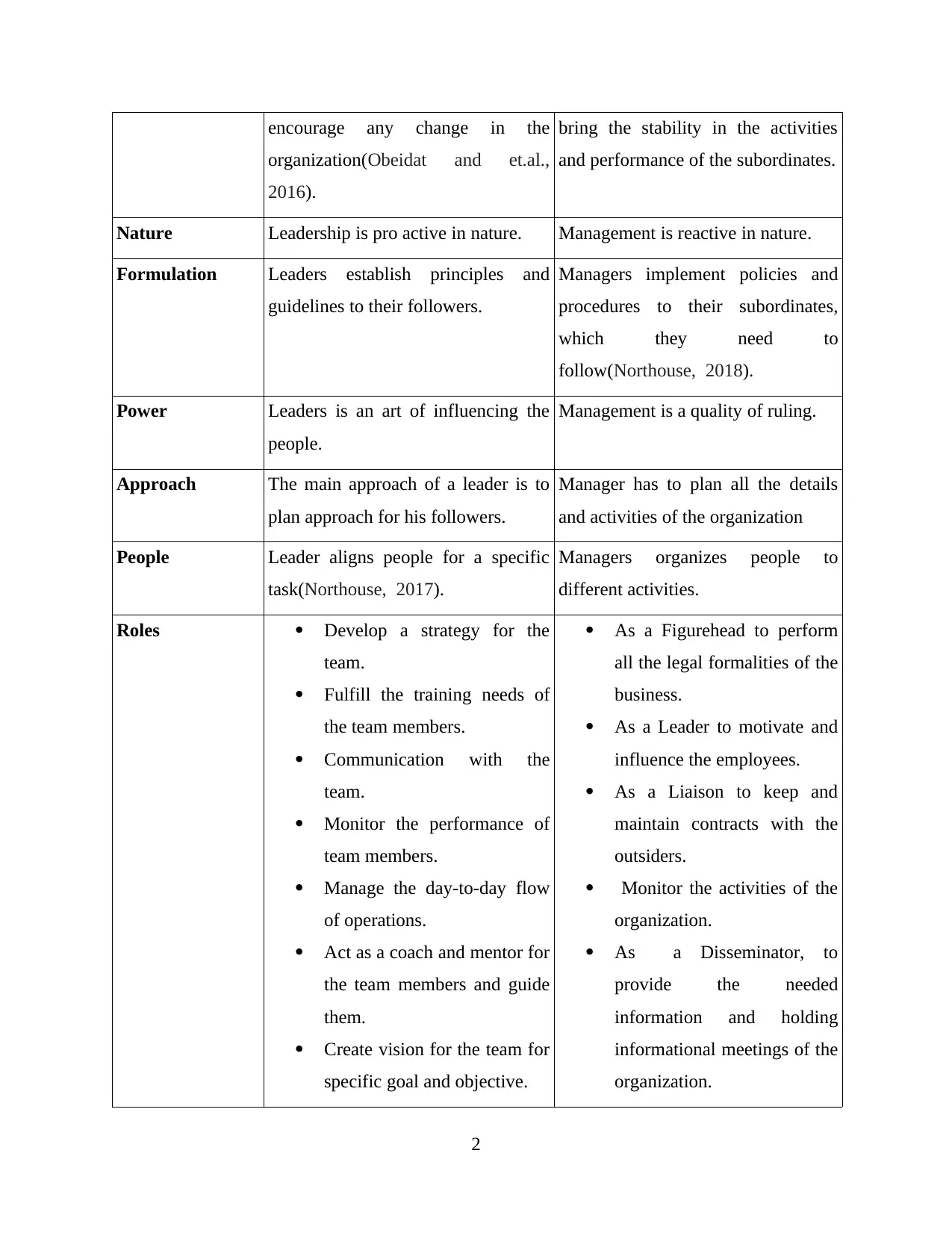
encourage any change in the
organization(Obeidat and et.al.,
2016).
bring the stability in the activities
and performance of the subordinates.
Nature Leadership is pro active in nature. Management is reactive in nature.
Formulation Leaders establish principles and
guidelines to their followers.
Managers implement policies and
procedures to their subordinates,
which they need to
follow(Northouse, 2018).
Power Leaders is an art of influencing the
people.
Management is a quality of ruling.
Approach The main approach of a leader is to
plan approach for his followers.
Manager has to plan all the details
and activities of the organization
People Leader aligns people for a specific
task(Northouse, 2017).
Managers organizes people to
different activities.
Roles Develop a strategy for the
team.
Fulfill the training needs of
the team members.
Communication with the
team.
Monitor the performance of
team members.
Manage the day-to-day flow
of operations.
Act as a coach and mentor for
the team members and guide
them.
Create vision for the team for
specific goal and objective.
As a Figurehead to perform
all the legal formalities of the
business.
As a Leader to motivate and
influence the employees.
As a Liaison to keep and
maintain contracts with the
outsiders.
Monitor the activities of the
organization.
As a Disseminator, to
provide the needed
information and holding
informational meetings of the
organization.
2
organization(Obeidat and et.al.,
2016).
bring the stability in the activities
and performance of the subordinates.
Nature Leadership is pro active in nature. Management is reactive in nature.
Formulation Leaders establish principles and
guidelines to their followers.
Managers implement policies and
procedures to their subordinates,
which they need to
follow(Northouse, 2018).
Power Leaders is an art of influencing the
people.
Management is a quality of ruling.
Approach The main approach of a leader is to
plan approach for his followers.
Manager has to plan all the details
and activities of the organization
People Leader aligns people for a specific
task(Northouse, 2017).
Managers organizes people to
different activities.
Roles Develop a strategy for the
team.
Fulfill the training needs of
the team members.
Communication with the
team.
Monitor the performance of
team members.
Manage the day-to-day flow
of operations.
Act as a coach and mentor for
the team members and guide
them.
Create vision for the team for
specific goal and objective.
As a Figurehead to perform
all the legal formalities of the
business.
As a Leader to motivate and
influence the employees.
As a Liaison to keep and
maintain contracts with the
outsiders.
Monitor the activities of the
organization.
As a Disseminator, to
provide the needed
information and holding
informational meetings of the
organization.
2
Paraphrase This Document
Need a fresh take? Get an instant paraphrase of this document with our AI Paraphraser
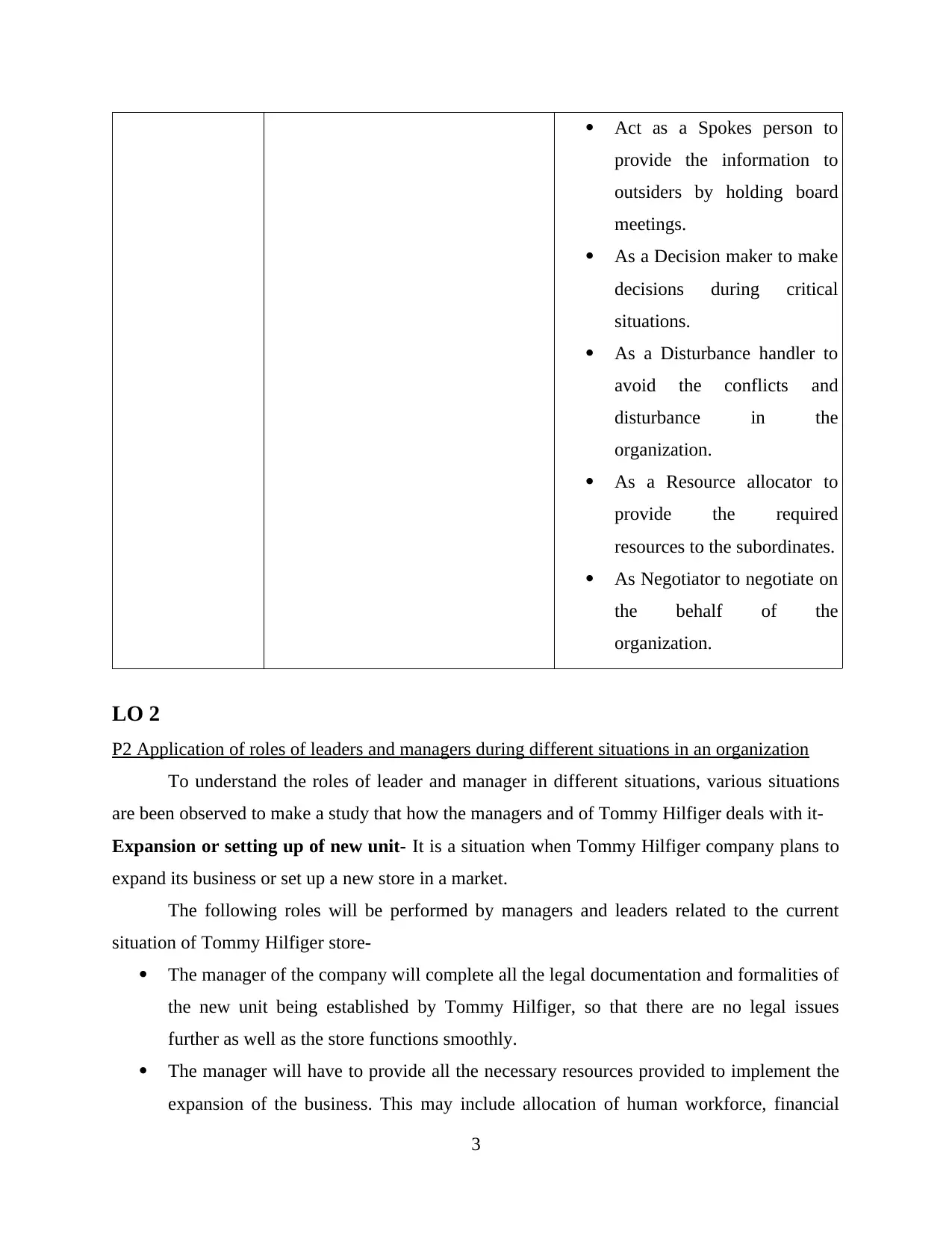
Act as a Spokes person to
provide the information to
outsiders by holding board
meetings.
As a Decision maker to make
decisions during critical
situations.
As a Disturbance handler to
avoid the conflicts and
disturbance in the
organization.
As a Resource allocator to
provide the required
resources to the subordinates.
As Negotiator to negotiate on
the behalf of the
organization.
LO 2
P2 Application of roles of leaders and managers during different situations in an organization
To understand the roles of leader and manager in different situations, various situations
are been observed to make a study that how the managers and of Tommy Hilfiger deals with it-
Expansion or setting up of new unit- It is a situation when Tommy Hilfiger company plans to
expand its business or set up a new store in a market.
The following roles will be performed by managers and leaders related to the current
situation of Tommy Hilfiger store-
The manager of the company will complete all the legal documentation and formalities of
the new unit being established by Tommy Hilfiger, so that there are no legal issues
further as well as the store functions smoothly.
The manager will have to provide all the necessary resources provided to implement the
expansion of the business. This may include allocation of human workforce, financial
3
provide the information to
outsiders by holding board
meetings.
As a Decision maker to make
decisions during critical
situations.
As a Disturbance handler to
avoid the conflicts and
disturbance in the
organization.
As a Resource allocator to
provide the required
resources to the subordinates.
As Negotiator to negotiate on
the behalf of the
organization.
LO 2
P2 Application of roles of leaders and managers during different situations in an organization
To understand the roles of leader and manager in different situations, various situations
are been observed to make a study that how the managers and of Tommy Hilfiger deals with it-
Expansion or setting up of new unit- It is a situation when Tommy Hilfiger company plans to
expand its business or set up a new store in a market.
The following roles will be performed by managers and leaders related to the current
situation of Tommy Hilfiger store-
The manager of the company will complete all the legal documentation and formalities of
the new unit being established by Tommy Hilfiger, so that there are no legal issues
further as well as the store functions smoothly.
The manager will have to provide all the necessary resources provided to implement the
expansion of the business. This may include allocation of human workforce, financial
3
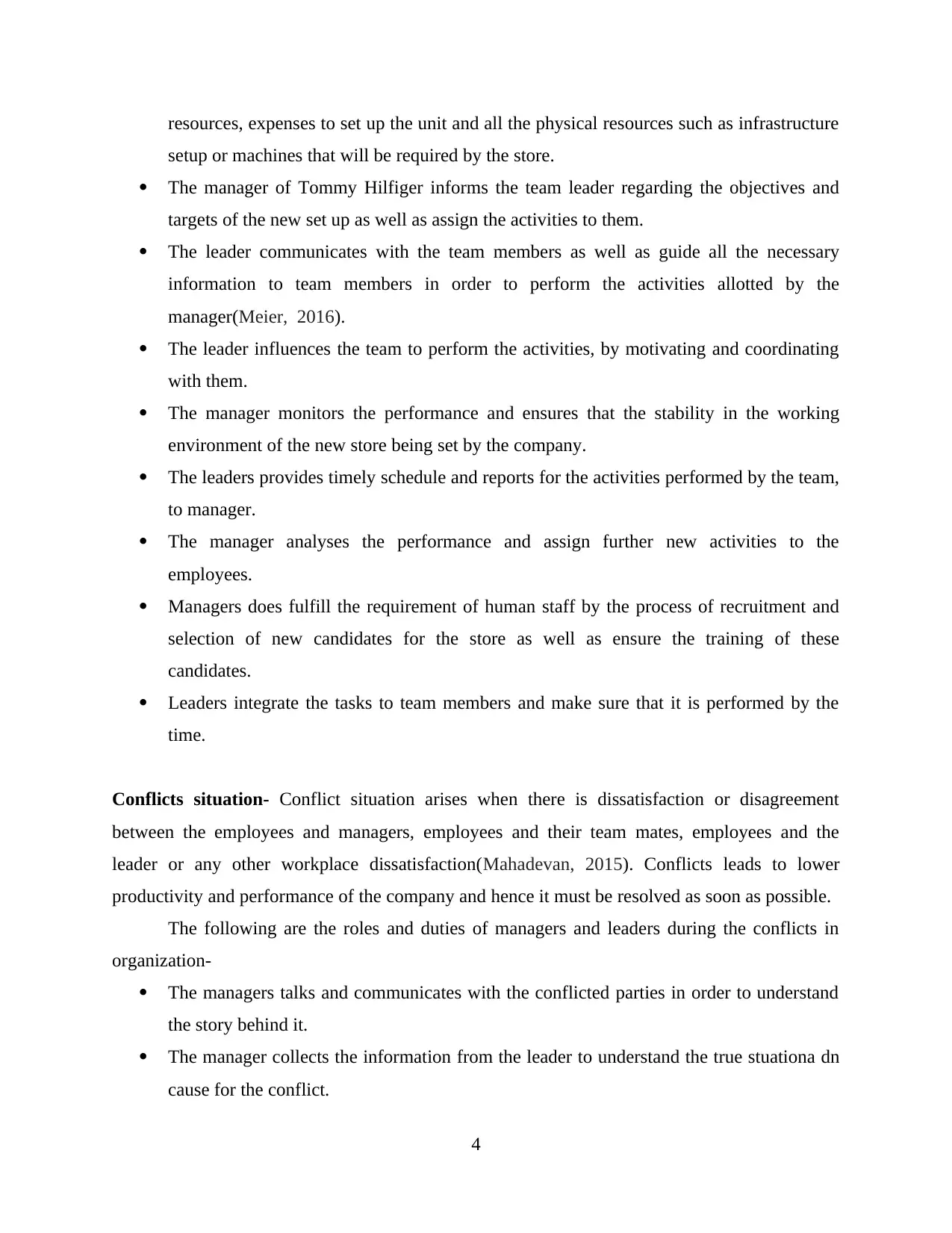
resources, expenses to set up the unit and all the physical resources such as infrastructure
setup or machines that will be required by the store.
The manager of Tommy Hilfiger informs the team leader regarding the objectives and
targets of the new set up as well as assign the activities to them.
The leader communicates with the team members as well as guide all the necessary
information to team members in order to perform the activities allotted by the
manager(Meier, 2016).
The leader influences the team to perform the activities, by motivating and coordinating
with them.
The manager monitors the performance and ensures that the stability in the working
environment of the new store being set by the company.
The leaders provides timely schedule and reports for the activities performed by the team,
to manager.
The manager analyses the performance and assign further new activities to the
employees.
Managers does fulfill the requirement of human staff by the process of recruitment and
selection of new candidates for the store as well as ensure the training of these
candidates.
Leaders integrate the tasks to team members and make sure that it is performed by the
time.
Conflicts situation- Conflict situation arises when there is dissatisfaction or disagreement
between the employees and managers, employees and their team mates, employees and the
leader or any other workplace dissatisfaction(Mahadevan, 2015). Conflicts leads to lower
productivity and performance of the company and hence it must be resolved as soon as possible.
The following are the roles and duties of managers and leaders during the conflicts in
organization-
The managers talks and communicates with the conflicted parties in order to understand
the story behind it.
The manager collects the information from the leader to understand the true stuationa dn
cause for the conflict.
4
setup or machines that will be required by the store.
The manager of Tommy Hilfiger informs the team leader regarding the objectives and
targets of the new set up as well as assign the activities to them.
The leader communicates with the team members as well as guide all the necessary
information to team members in order to perform the activities allotted by the
manager(Meier, 2016).
The leader influences the team to perform the activities, by motivating and coordinating
with them.
The manager monitors the performance and ensures that the stability in the working
environment of the new store being set by the company.
The leaders provides timely schedule and reports for the activities performed by the team,
to manager.
The manager analyses the performance and assign further new activities to the
employees.
Managers does fulfill the requirement of human staff by the process of recruitment and
selection of new candidates for the store as well as ensure the training of these
candidates.
Leaders integrate the tasks to team members and make sure that it is performed by the
time.
Conflicts situation- Conflict situation arises when there is dissatisfaction or disagreement
between the employees and managers, employees and their team mates, employees and the
leader or any other workplace dissatisfaction(Mahadevan, 2015). Conflicts leads to lower
productivity and performance of the company and hence it must be resolved as soon as possible.
The following are the roles and duties of managers and leaders during the conflicts in
organization-
The managers talks and communicates with the conflicted parties in order to understand
the story behind it.
The manager collects the information from the leader to understand the true stuationa dn
cause for the conflict.
4
⊘ This is a preview!⊘
Do you want full access?
Subscribe today to unlock all pages.

Trusted by 1+ million students worldwide
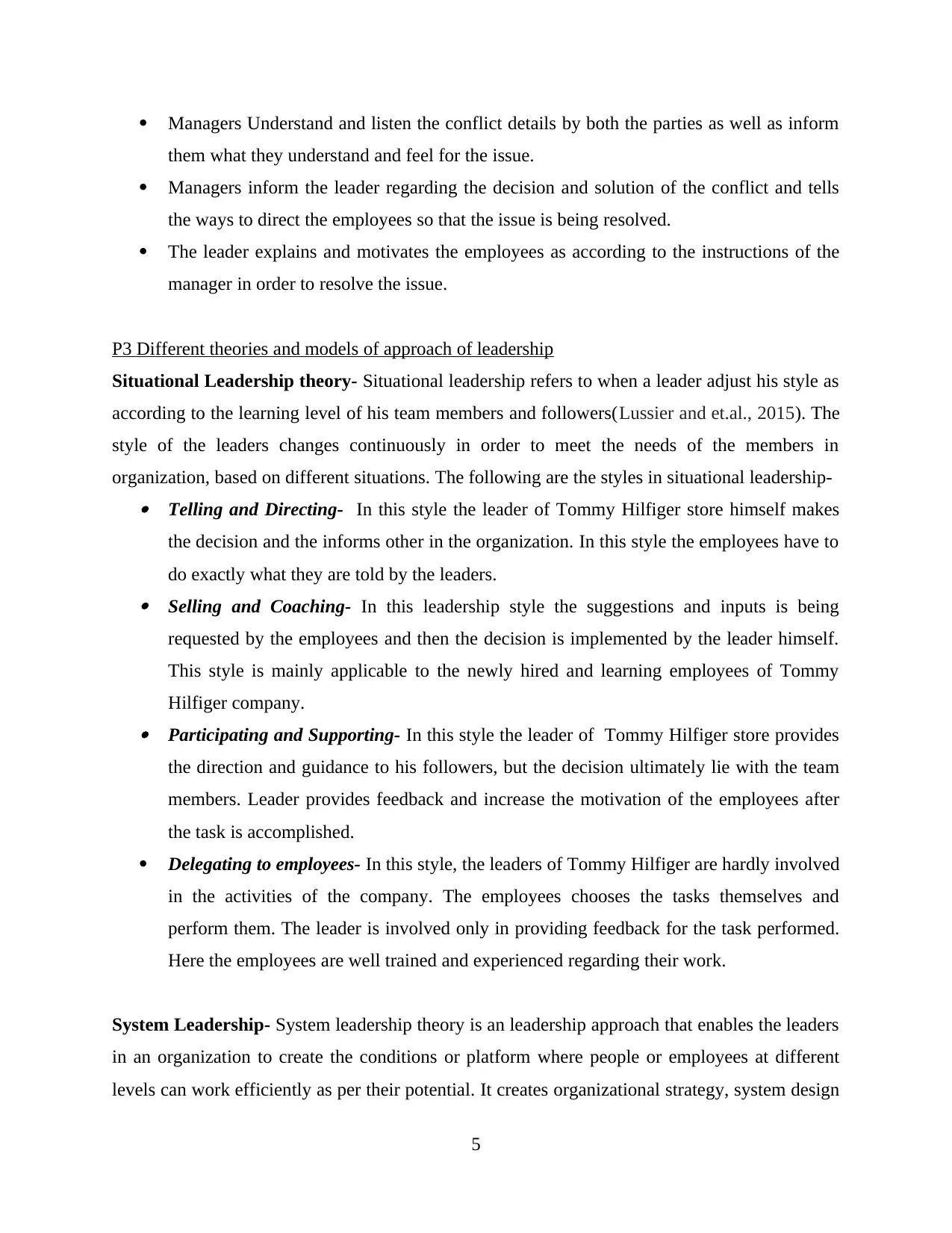
Managers Understand and listen the conflict details by both the parties as well as inform
them what they understand and feel for the issue.
Managers inform the leader regarding the decision and solution of the conflict and tells
the ways to direct the employees so that the issue is being resolved.
The leader explains and motivates the employees as according to the instructions of the
manager in order to resolve the issue.
P3 Different theories and models of approach of leadership
Situational Leadership theory- Situational leadership refers to when a leader adjust his style as
according to the learning level of his team members and followers(Lussier and et.al., 2015). The
style of the leaders changes continuously in order to meet the needs of the members in
organization, based on different situations. The following are the styles in situational leadership- Telling and Directing- In this style the leader of Tommy Hilfiger store himself makes
the decision and the informs other in the organization. In this style the employees have to
do exactly what they are told by the leaders. Selling and Coaching- In this leadership style the suggestions and inputs is being
requested by the employees and then the decision is implemented by the leader himself.
This style is mainly applicable to the newly hired and learning employees of Tommy
Hilfiger company. Participating and Supporting- In this style the leader of Tommy Hilfiger store provides
the direction and guidance to his followers, but the decision ultimately lie with the team
members. Leader provides feedback and increase the motivation of the employees after
the task is accomplished.
Delegating to employees- In this style, the leaders of Tommy Hilfiger are hardly involved
in the activities of the company. The employees chooses the tasks themselves and
perform them. The leader is involved only in providing feedback for the task performed.
Here the employees are well trained and experienced regarding their work.
System Leadership- System leadership theory is an leadership approach that enables the leaders
in an organization to create the conditions or platform where people or employees at different
levels can work efficiently as per their potential. It creates organizational strategy, system design
5
them what they understand and feel for the issue.
Managers inform the leader regarding the decision and solution of the conflict and tells
the ways to direct the employees so that the issue is being resolved.
The leader explains and motivates the employees as according to the instructions of the
manager in order to resolve the issue.
P3 Different theories and models of approach of leadership
Situational Leadership theory- Situational leadership refers to when a leader adjust his style as
according to the learning level of his team members and followers(Lussier and et.al., 2015). The
style of the leaders changes continuously in order to meet the needs of the members in
organization, based on different situations. The following are the styles in situational leadership- Telling and Directing- In this style the leader of Tommy Hilfiger store himself makes
the decision and the informs other in the organization. In this style the employees have to
do exactly what they are told by the leaders. Selling and Coaching- In this leadership style the suggestions and inputs is being
requested by the employees and then the decision is implemented by the leader himself.
This style is mainly applicable to the newly hired and learning employees of Tommy
Hilfiger company. Participating and Supporting- In this style the leader of Tommy Hilfiger store provides
the direction and guidance to his followers, but the decision ultimately lie with the team
members. Leader provides feedback and increase the motivation of the employees after
the task is accomplished.
Delegating to employees- In this style, the leaders of Tommy Hilfiger are hardly involved
in the activities of the company. The employees chooses the tasks themselves and
perform them. The leader is involved only in providing feedback for the task performed.
Here the employees are well trained and experienced regarding their work.
System Leadership- System leadership theory is an leadership approach that enables the leaders
in an organization to create the conditions or platform where people or employees at different
levels can work efficiently as per their potential. It creates organizational strategy, system design
5
Paraphrase This Document
Need a fresh take? Get an instant paraphrase of this document with our AI Paraphraser
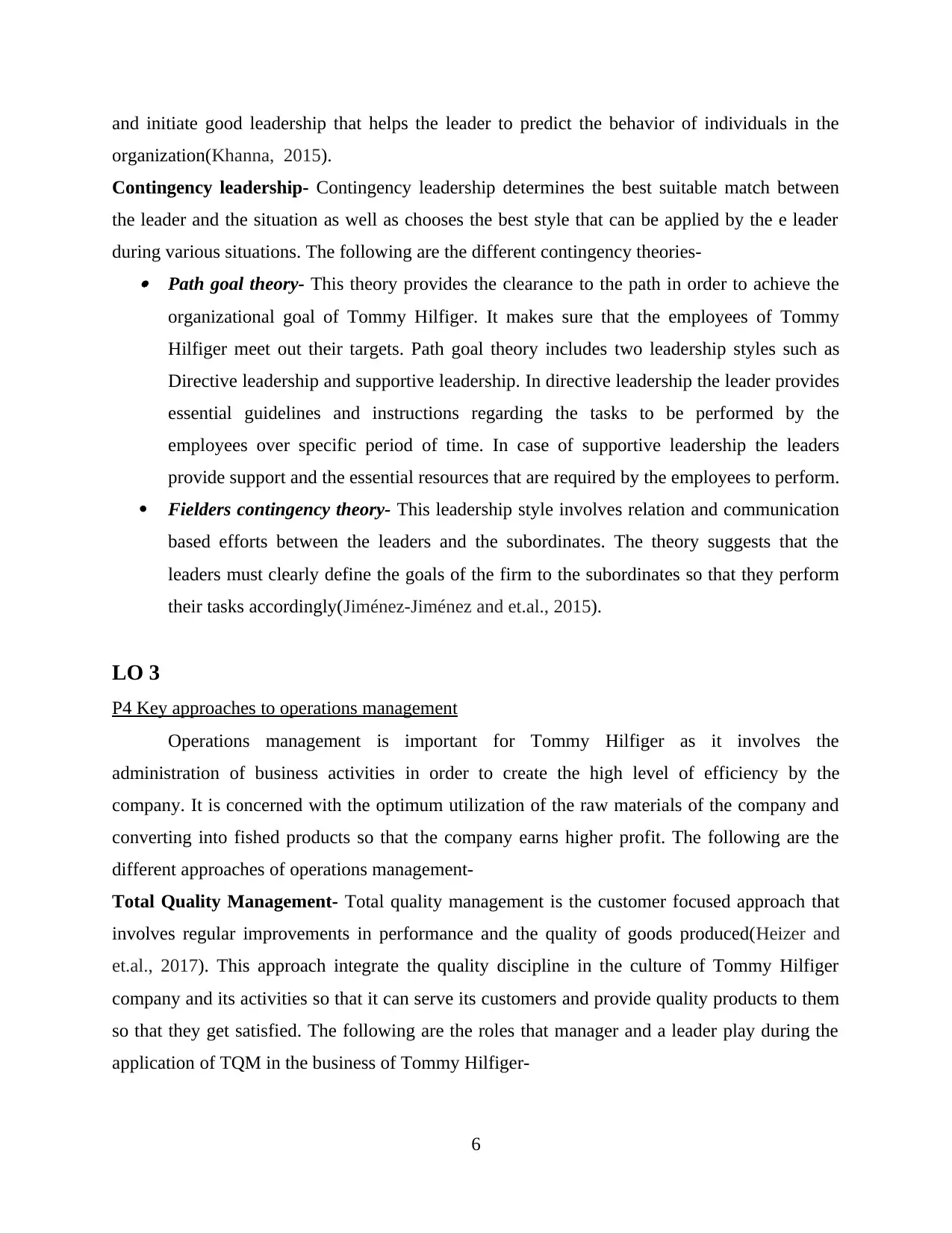
and initiate good leadership that helps the leader to predict the behavior of individuals in the
organization(Khanna, 2015).
Contingency leadership- Contingency leadership determines the best suitable match between
the leader and the situation as well as chooses the best style that can be applied by the e leader
during various situations. The following are the different contingency theories- Path goal theory- This theory provides the clearance to the path in order to achieve the
organizational goal of Tommy Hilfiger. It makes sure that the employees of Tommy
Hilfiger meet out their targets. Path goal theory includes two leadership styles such as
Directive leadership and supportive leadership. In directive leadership the leader provides
essential guidelines and instructions regarding the tasks to be performed by the
employees over specific period of time. In case of supportive leadership the leaders
provide support and the essential resources that are required by the employees to perform.
Fielders contingency theory- This leadership style involves relation and communication
based efforts between the leaders and the subordinates. The theory suggests that the
leaders must clearly define the goals of the firm to the subordinates so that they perform
their tasks accordingly(Jiménez-Jiménez and et.al., 2015).
LO 3
P4 Key approaches to operations management
Operations management is important for Tommy Hilfiger as it involves the
administration of business activities in order to create the high level of efficiency by the
company. It is concerned with the optimum utilization of the raw materials of the company and
converting into fished products so that the company earns higher profit. The following are the
different approaches of operations management-
Total Quality Management- Total quality management is the customer focused approach that
involves regular improvements in performance and the quality of goods produced(Heizer and
et.al., 2017). This approach integrate the quality discipline in the culture of Tommy Hilfiger
company and its activities so that it can serve its customers and provide quality products to them
so that they get satisfied. The following are the roles that manager and a leader play during the
application of TQM in the business of Tommy Hilfiger-
6
organization(Khanna, 2015).
Contingency leadership- Contingency leadership determines the best suitable match between
the leader and the situation as well as chooses the best style that can be applied by the e leader
during various situations. The following are the different contingency theories- Path goal theory- This theory provides the clearance to the path in order to achieve the
organizational goal of Tommy Hilfiger. It makes sure that the employees of Tommy
Hilfiger meet out their targets. Path goal theory includes two leadership styles such as
Directive leadership and supportive leadership. In directive leadership the leader provides
essential guidelines and instructions regarding the tasks to be performed by the
employees over specific period of time. In case of supportive leadership the leaders
provide support and the essential resources that are required by the employees to perform.
Fielders contingency theory- This leadership style involves relation and communication
based efforts between the leaders and the subordinates. The theory suggests that the
leaders must clearly define the goals of the firm to the subordinates so that they perform
their tasks accordingly(Jiménez-Jiménez and et.al., 2015).
LO 3
P4 Key approaches to operations management
Operations management is important for Tommy Hilfiger as it involves the
administration of business activities in order to create the high level of efficiency by the
company. It is concerned with the optimum utilization of the raw materials of the company and
converting into fished products so that the company earns higher profit. The following are the
different approaches of operations management-
Total Quality Management- Total quality management is the customer focused approach that
involves regular improvements in performance and the quality of goods produced(Heizer and
et.al., 2017). This approach integrate the quality discipline in the culture of Tommy Hilfiger
company and its activities so that it can serve its customers and provide quality products to them
so that they get satisfied. The following are the roles that manager and a leader play during the
application of TQM in the business of Tommy Hilfiger-
6
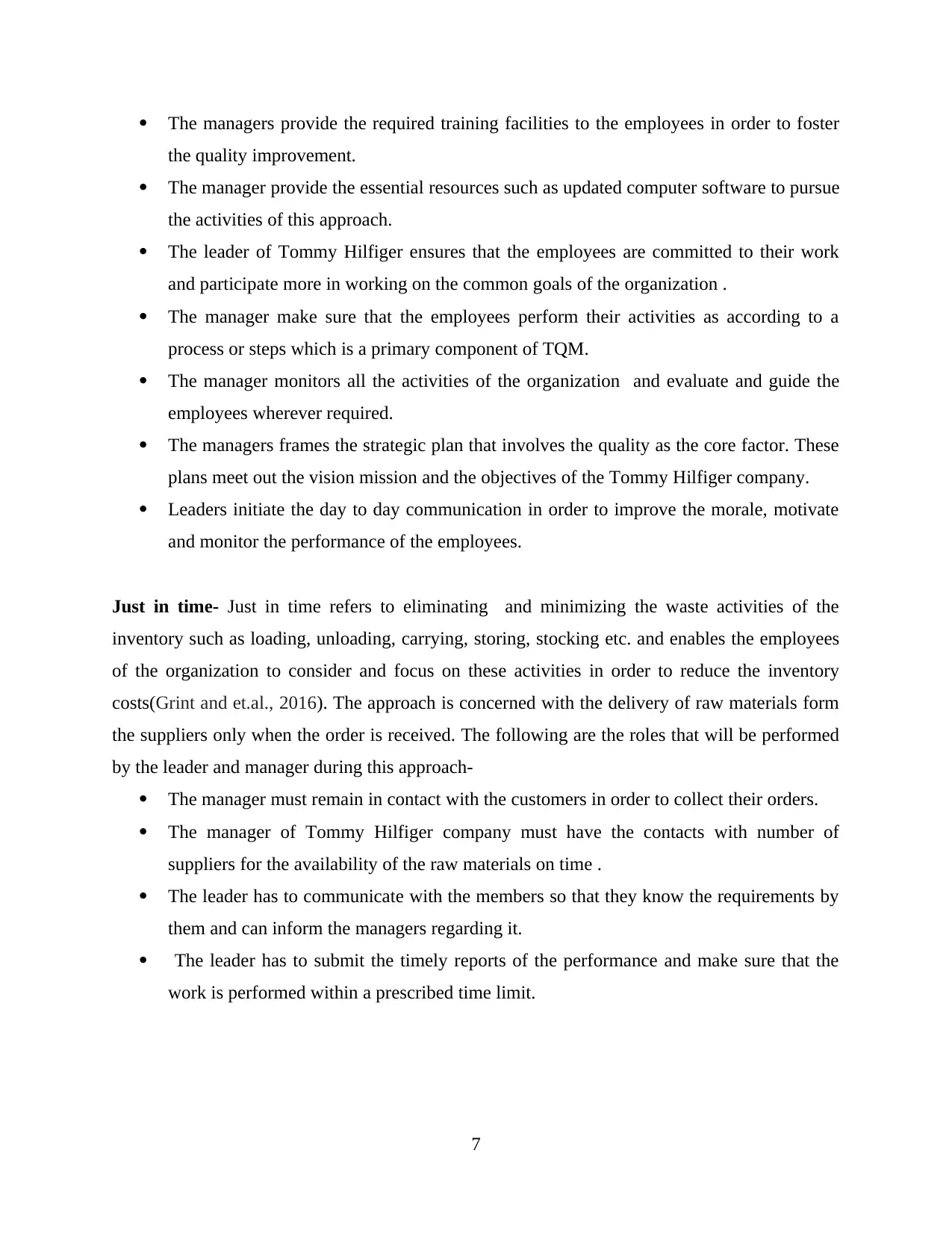
The managers provide the required training facilities to the employees in order to foster
the quality improvement.
The manager provide the essential resources such as updated computer software to pursue
the activities of this approach.
The leader of Tommy Hilfiger ensures that the employees are committed to their work
and participate more in working on the common goals of the organization .
The manager make sure that the employees perform their activities as according to a
process or steps which is a primary component of TQM.
The manager monitors all the activities of the organization and evaluate and guide the
employees wherever required.
The managers frames the strategic plan that involves the quality as the core factor. These
plans meet out the vision mission and the objectives of the Tommy Hilfiger company.
Leaders initiate the day to day communication in order to improve the morale, motivate
and monitor the performance of the employees.
Just in time- Just in time refers to eliminating and minimizing the waste activities of the
inventory such as loading, unloading, carrying, storing, stocking etc. and enables the employees
of the organization to consider and focus on these activities in order to reduce the inventory
costs(Grint and et.al., 2016). The approach is concerned with the delivery of raw materials form
the suppliers only when the order is received. The following are the roles that will be performed
by the leader and manager during this approach-
The manager must remain in contact with the customers in order to collect their orders.
The manager of Tommy Hilfiger company must have the contacts with number of
suppliers for the availability of the raw materials on time .
The leader has to communicate with the members so that they know the requirements by
them and can inform the managers regarding it.
The leader has to submit the timely reports of the performance and make sure that the
work is performed within a prescribed time limit.
7
the quality improvement.
The manager provide the essential resources such as updated computer software to pursue
the activities of this approach.
The leader of Tommy Hilfiger ensures that the employees are committed to their work
and participate more in working on the common goals of the organization .
The manager make sure that the employees perform their activities as according to a
process or steps which is a primary component of TQM.
The manager monitors all the activities of the organization and evaluate and guide the
employees wherever required.
The managers frames the strategic plan that involves the quality as the core factor. These
plans meet out the vision mission and the objectives of the Tommy Hilfiger company.
Leaders initiate the day to day communication in order to improve the morale, motivate
and monitor the performance of the employees.
Just in time- Just in time refers to eliminating and minimizing the waste activities of the
inventory such as loading, unloading, carrying, storing, stocking etc. and enables the employees
of the organization to consider and focus on these activities in order to reduce the inventory
costs(Grint and et.al., 2016). The approach is concerned with the delivery of raw materials form
the suppliers only when the order is received. The following are the roles that will be performed
by the leader and manager during this approach-
The manager must remain in contact with the customers in order to collect their orders.
The manager of Tommy Hilfiger company must have the contacts with number of
suppliers for the availability of the raw materials on time .
The leader has to communicate with the members so that they know the requirements by
them and can inform the managers regarding it.
The leader has to submit the timely reports of the performance and make sure that the
work is performed within a prescribed time limit.
7
⊘ This is a preview!⊘
Do you want full access?
Subscribe today to unlock all pages.

Trusted by 1+ million students worldwide
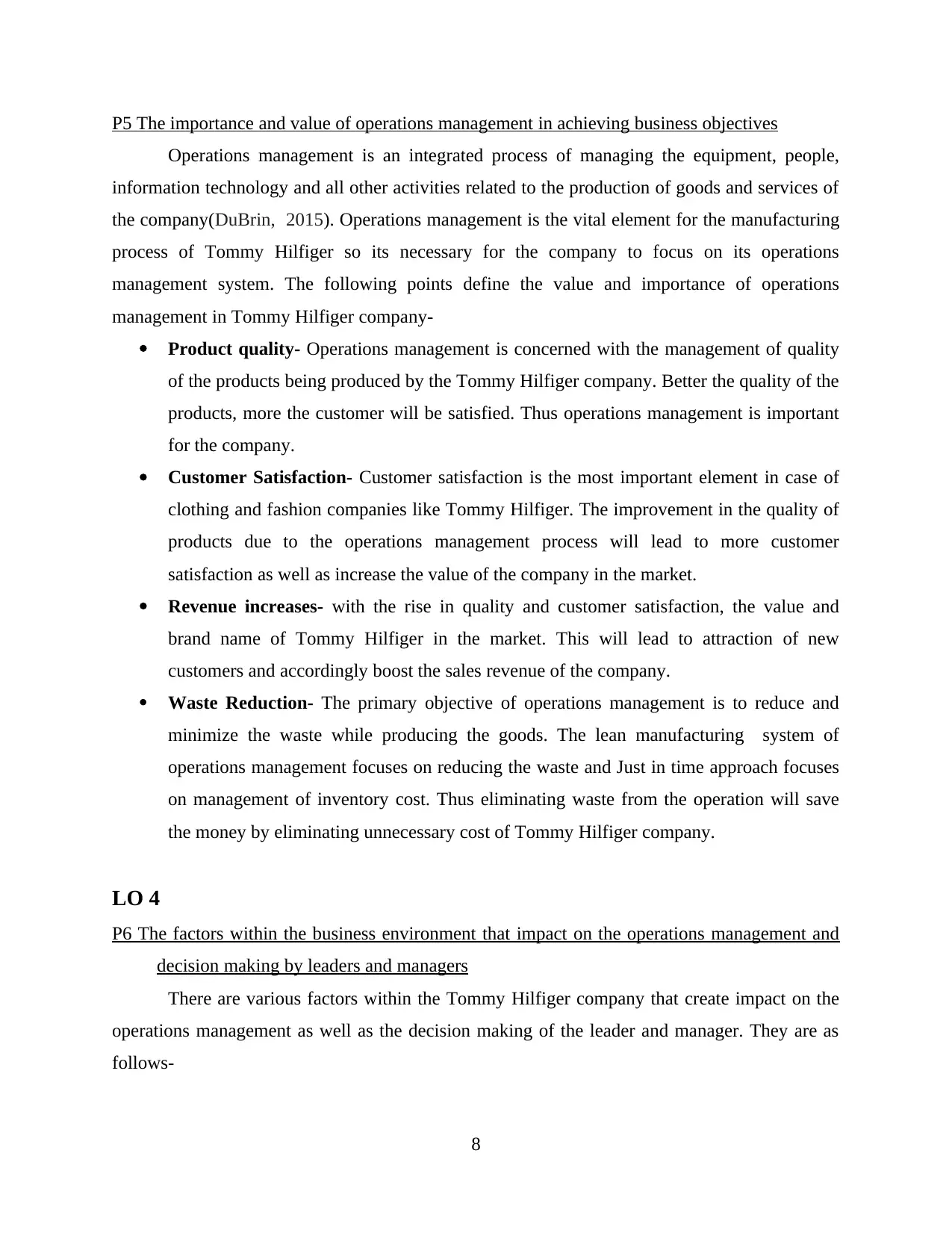
P5 The importance and value of operations management in achieving business objectives
Operations management is an integrated process of managing the equipment, people,
information technology and all other activities related to the production of goods and services of
the company(DuBrin, 2015). Operations management is the vital element for the manufacturing
process of Tommy Hilfiger so its necessary for the company to focus on its operations
management system. The following points define the value and importance of operations
management in Tommy Hilfiger company-
Product quality- Operations management is concerned with the management of quality
of the products being produced by the Tommy Hilfiger company. Better the quality of the
products, more the customer will be satisfied. Thus operations management is important
for the company.
Customer Satisfaction- Customer satisfaction is the most important element in case of
clothing and fashion companies like Tommy Hilfiger. The improvement in the quality of
products due to the operations management process will lead to more customer
satisfaction as well as increase the value of the company in the market.
Revenue increases- with the rise in quality and customer satisfaction, the value and
brand name of Tommy Hilfiger in the market. This will lead to attraction of new
customers and accordingly boost the sales revenue of the company.
Waste Reduction- The primary objective of operations management is to reduce and
minimize the waste while producing the goods. The lean manufacturing system of
operations management focuses on reducing the waste and Just in time approach focuses
on management of inventory cost. Thus eliminating waste from the operation will save
the money by eliminating unnecessary cost of Tommy Hilfiger company.
LO 4
P6 The factors within the business environment that impact on the operations management and
decision making by leaders and managers
There are various factors within the Tommy Hilfiger company that create impact on the
operations management as well as the decision making of the leader and manager. They are as
follows-
8
Operations management is an integrated process of managing the equipment, people,
information technology and all other activities related to the production of goods and services of
the company(DuBrin, 2015). Operations management is the vital element for the manufacturing
process of Tommy Hilfiger so its necessary for the company to focus on its operations
management system. The following points define the value and importance of operations
management in Tommy Hilfiger company-
Product quality- Operations management is concerned with the management of quality
of the products being produced by the Tommy Hilfiger company. Better the quality of the
products, more the customer will be satisfied. Thus operations management is important
for the company.
Customer Satisfaction- Customer satisfaction is the most important element in case of
clothing and fashion companies like Tommy Hilfiger. The improvement in the quality of
products due to the operations management process will lead to more customer
satisfaction as well as increase the value of the company in the market.
Revenue increases- with the rise in quality and customer satisfaction, the value and
brand name of Tommy Hilfiger in the market. This will lead to attraction of new
customers and accordingly boost the sales revenue of the company.
Waste Reduction- The primary objective of operations management is to reduce and
minimize the waste while producing the goods. The lean manufacturing system of
operations management focuses on reducing the waste and Just in time approach focuses
on management of inventory cost. Thus eliminating waste from the operation will save
the money by eliminating unnecessary cost of Tommy Hilfiger company.
LO 4
P6 The factors within the business environment that impact on the operations management and
decision making by leaders and managers
There are various factors within the Tommy Hilfiger company that create impact on the
operations management as well as the decision making of the leader and manager. They are as
follows-
8
Paraphrase This Document
Need a fresh take? Get an instant paraphrase of this document with our AI Paraphraser
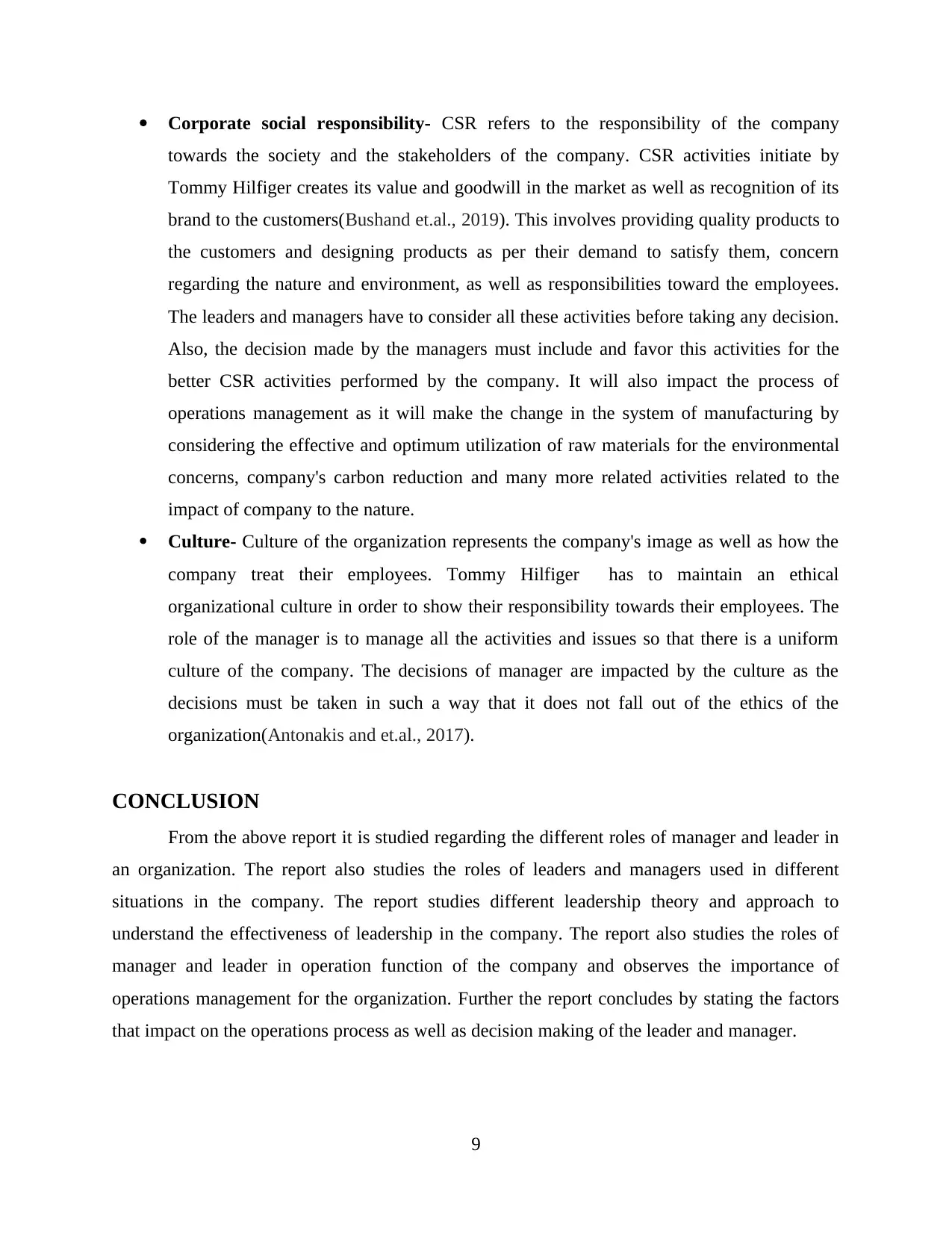
Corporate social responsibility- CSR refers to the responsibility of the company
towards the society and the stakeholders of the company. CSR activities initiate by
Tommy Hilfiger creates its value and goodwill in the market as well as recognition of its
brand to the customers(Bushand et.al., 2019). This involves providing quality products to
the customers and designing products as per their demand to satisfy them, concern
regarding the nature and environment, as well as responsibilities toward the employees.
The leaders and managers have to consider all these activities before taking any decision.
Also, the decision made by the managers must include and favor this activities for the
better CSR activities performed by the company. It will also impact the process of
operations management as it will make the change in the system of manufacturing by
considering the effective and optimum utilization of raw materials for the environmental
concerns, company's carbon reduction and many more related activities related to the
impact of company to the nature.
Culture- Culture of the organization represents the company's image as well as how the
company treat their employees. Tommy Hilfiger has to maintain an ethical
organizational culture in order to show their responsibility towards their employees. The
role of the manager is to manage all the activities and issues so that there is a uniform
culture of the company. The decisions of manager are impacted by the culture as the
decisions must be taken in such a way that it does not fall out of the ethics of the
organization(Antonakis and et.al., 2017).
CONCLUSION
From the above report it is studied regarding the different roles of manager and leader in
an organization. The report also studies the roles of leaders and managers used in different
situations in the company. The report studies different leadership theory and approach to
understand the effectiveness of leadership in the company. The report also studies the roles of
manager and leader in operation function of the company and observes the importance of
operations management for the organization. Further the report concludes by stating the factors
that impact on the operations process as well as decision making of the leader and manager.
9
towards the society and the stakeholders of the company. CSR activities initiate by
Tommy Hilfiger creates its value and goodwill in the market as well as recognition of its
brand to the customers(Bushand et.al., 2019). This involves providing quality products to
the customers and designing products as per their demand to satisfy them, concern
regarding the nature and environment, as well as responsibilities toward the employees.
The leaders and managers have to consider all these activities before taking any decision.
Also, the decision made by the managers must include and favor this activities for the
better CSR activities performed by the company. It will also impact the process of
operations management as it will make the change in the system of manufacturing by
considering the effective and optimum utilization of raw materials for the environmental
concerns, company's carbon reduction and many more related activities related to the
impact of company to the nature.
Culture- Culture of the organization represents the company's image as well as how the
company treat their employees. Tommy Hilfiger has to maintain an ethical
organizational culture in order to show their responsibility towards their employees. The
role of the manager is to manage all the activities and issues so that there is a uniform
culture of the company. The decisions of manager are impacted by the culture as the
decisions must be taken in such a way that it does not fall out of the ethics of the
organization(Antonakis and et.al., 2017).
CONCLUSION
From the above report it is studied regarding the different roles of manager and leader in
an organization. The report also studies the roles of leaders and managers used in different
situations in the company. The report studies different leadership theory and approach to
understand the effectiveness of leadership in the company. The report also studies the roles of
manager and leader in operation function of the company and observes the importance of
operations management for the organization. Further the report concludes by stating the factors
that impact on the operations process as well as decision making of the leader and manager.
9
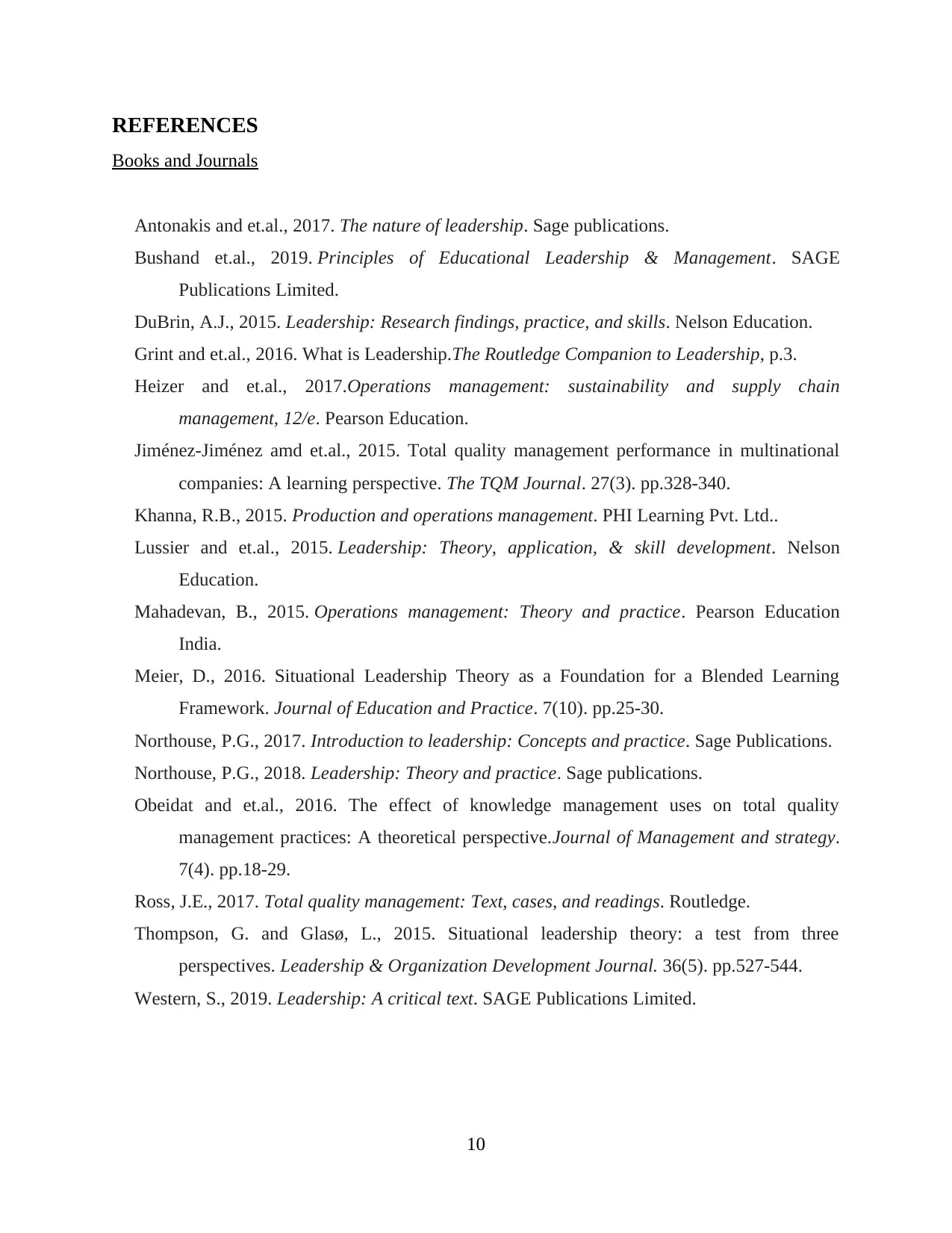
REFERENCES
Books and Journals
Antonakis and et.al., 2017. The nature of leadership. Sage publications.
Bushand et.al., 2019. Principles of Educational Leadership & Management. SAGE
Publications Limited.
DuBrin, A.J., 2015. Leadership: Research findings, practice, and skills. Nelson Education.
Grint and et.al., 2016. What is Leadership.The Routledge Companion to Leadership, p.3.
Heizer and et.al., 2017.Operations management: sustainability and supply chain
management, 12/e. Pearson Education.
Jiménez-Jiménez amd et.al., 2015. Total quality management performance in multinational
companies: A learning perspective. The TQM Journal. 27(3). pp.328-340.
Khanna, R.B., 2015. Production and operations management. PHI Learning Pvt. Ltd..
Lussier and et.al., 2015. Leadership: Theory, application, & skill development. Nelson
Education.
Mahadevan, B., 2015. Operations management: Theory and practice. Pearson Education
India.
Meier, D., 2016. Situational Leadership Theory as a Foundation for a Blended Learning
Framework. Journal of Education and Practice. 7(10). pp.25-30.
Northouse, P.G., 2017. Introduction to leadership: Concepts and practice. Sage Publications.
Northouse, P.G., 2018. Leadership: Theory and practice. Sage publications.
Obeidat and et.al., 2016. The effect of knowledge management uses on total quality
management practices: A theoretical perspective.Journal of Management and strategy.
7(4). pp.18-29.
Ross, J.E., 2017. Total quality management: Text, cases, and readings. Routledge.
Thompson, G. and Glasø, L., 2015. Situational leadership theory: a test from three
perspectives. Leadership & Organization Development Journal. 36(5). pp.527-544.
Western, S., 2019. Leadership: A critical text. SAGE Publications Limited.
10
Books and Journals
Antonakis and et.al., 2017. The nature of leadership. Sage publications.
Bushand et.al., 2019. Principles of Educational Leadership & Management. SAGE
Publications Limited.
DuBrin, A.J., 2015. Leadership: Research findings, practice, and skills. Nelson Education.
Grint and et.al., 2016. What is Leadership.The Routledge Companion to Leadership, p.3.
Heizer and et.al., 2017.Operations management: sustainability and supply chain
management, 12/e. Pearson Education.
Jiménez-Jiménez amd et.al., 2015. Total quality management performance in multinational
companies: A learning perspective. The TQM Journal. 27(3). pp.328-340.
Khanna, R.B., 2015. Production and operations management. PHI Learning Pvt. Ltd..
Lussier and et.al., 2015. Leadership: Theory, application, & skill development. Nelson
Education.
Mahadevan, B., 2015. Operations management: Theory and practice. Pearson Education
India.
Meier, D., 2016. Situational Leadership Theory as a Foundation for a Blended Learning
Framework. Journal of Education and Practice. 7(10). pp.25-30.
Northouse, P.G., 2017. Introduction to leadership: Concepts and practice. Sage Publications.
Northouse, P.G., 2018. Leadership: Theory and practice. Sage publications.
Obeidat and et.al., 2016. The effect of knowledge management uses on total quality
management practices: A theoretical perspective.Journal of Management and strategy.
7(4). pp.18-29.
Ross, J.E., 2017. Total quality management: Text, cases, and readings. Routledge.
Thompson, G. and Glasø, L., 2015. Situational leadership theory: a test from three
perspectives. Leadership & Organization Development Journal. 36(5). pp.527-544.
Western, S., 2019. Leadership: A critical text. SAGE Publications Limited.
10
⊘ This is a preview!⊘
Do you want full access?
Subscribe today to unlock all pages.

Trusted by 1+ million students worldwide
1 out of 12
Related Documents
Your All-in-One AI-Powered Toolkit for Academic Success.
+13062052269
info@desklib.com
Available 24*7 on WhatsApp / Email
![[object Object]](/_next/static/media/star-bottom.7253800d.svg)
Unlock your academic potential
Copyright © 2020–2025 A2Z Services. All Rights Reserved. Developed and managed by ZUCOL.





